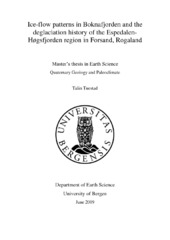| dc.contributor.author | Tuestad, Talin | |
| dc.date.accessioned | 2019-06-26T00:32:05Z | |
| dc.date.available | 2019-06-26T00:32:05Z | |
| dc.date.issued | 2019-06-26 | |
| dc.date.submitted | 2019-06-25T22:00:14Z | |
| dc.identifier.uri | https://hdl.handle.net/1956/20419 | |
| dc.description.abstract | Over 1000 glacial striation observations have been collected from various published and unpublished sources and compiled in a GIS striations database for Rogaland. An interpretation of the major flow sets represented by the collected striae is presented and compared with the existing knowledge of the deglaciation history in the Boknafjord region. Four major flow sets from the early deglaciation Boknafjorden have been identified. The oldest relative flow is represented by northerly striae along the outmost coast attributed to the northerly flowing Norwegian Channel Ice Stream (NCIS) that was active near the end of the Last Glacial Maximum. Following the collapse of the NCIS, striae show that ice flowed towards the west, which was followed by a distinct southwesterly flow out of Boknafjorden. A younger southerly flow along northern Boknafjorden reflects the development of a calving ice margin in the large and wide fjord. This thesis then focuses on the Espedalen-Høgsfjorden region in Forsand to the southeast of Boknafjorden, where 10Be surface exposure dating was combined with LiDAR-based geomorphological mapping and field observations of sediment sections exposed in a gravel pit at Nedre Espedal to investigate the deglaciation history of the region. Observations indicate that Espedalen and the adjacent higher elevation Lauvvatnet region were both occupied by ice-dammed lakes at an early phase during deglaciation. The subsequent drainage of these lakes reflects the gradual thinning and ultimate retreat of the damming ice-lobe in Høgsfjorden-Frafjorden. Two ice margins are located in Espedalen distal to the Younger Dryas ice sheet margin mapped by Andersen (1954). Although a proper chronology has not yet been established, the older ice margin is an ice-contact delta that corresponds with the oldest ice-dammed lake phase in Espedalen and is believed to represent standstill during the net ice retreat. A relatively younger ice front at Øvre Espedal may belong to a regional readvance that corresponds to the Older Dryas period. Further studies are necessary to constrain the deglacial chronology for the Espedalen-Høgsfjorden region. The resulting 10Be ages from two summits in Forsand exhibit a large spread in ages from ~13 to ~18 ka and thus are inconclusive. By comparing the most reliable ages with other nearby 10Be ages in Forsand, a deglaciation age of around 15 ka is suggested. | en_US |
| dc.language.iso | eng | |
| dc.publisher | The University of Bergen | en_US |
| dc.title | Ice-flow patterns in Boknafjorden and the deglaciations history of the Espedalen-Høgsfjorden region in Forsand, Rogaland | |
| dc.type | Master thesis | |
| dc.date.updated | 2019-06-25T22:00:14Z | |
| dc.rights.holder | Copyright the Author. All rights reserved | en_US |
| dc.description.degree | Master's Thesis in Earth Science | en_US |
| dc.description.localcode | GEOV399 | |
| dc.description.localcode | MAMN-GEOV | |
| dc.subject.nus | 756199 | |
| fs.subjectcode | GEOV399 | |
| fs.unitcode | 12-50-0 | |
